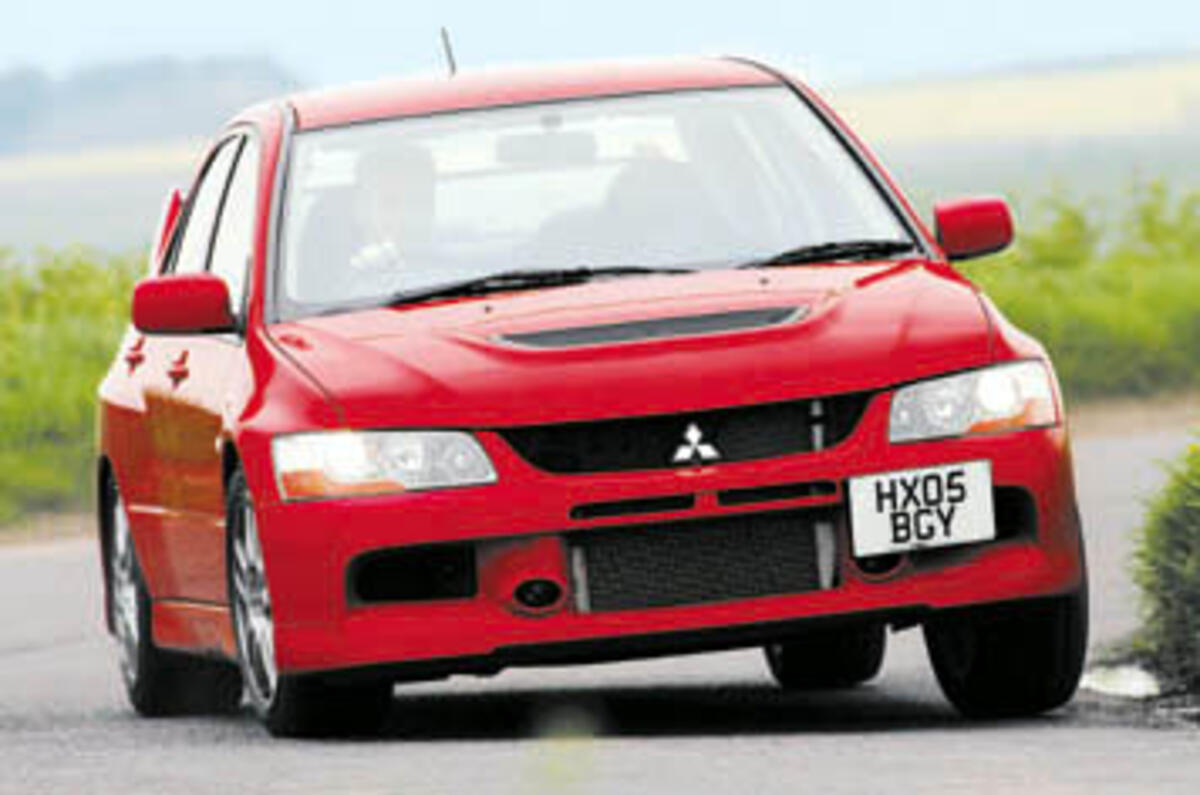What’s Japanese for a swift goodbye? No idea, but Mitsubishi’s new Lancer Evo IX, the last hurrah for the Evo as we know it, seems a fitting symbol. A transformation into a hatchback awaits in 2007, but until then the answer to life, the universe and everything (all right, getting from A to B quicker than you can say ‘supercar’) is nine.For 2005, as in the past 13 years, the Evo’s evolution has been fuelled by the demands of the FIA World Rally Championship. The IX is actually the 12th motorsport-inspired model, spanning three generations of Lancer. The first was introduced in 1992 to comply with FIA Group A rally regs. Mitsubishi describes the IX as a ‘subtle but significant’ development of the special-edition Evo VIII MR.Chief among the numerous detail improvements is the application of the company’s MIVEC variable valve timing to the already highly evolved 1997cc four-cylinder twin-scroll turbo engine. MIVEC constantly matches the inlet valve timing to engine speed and load. As well as improving the engine’s aerobic capacity, it also stabilises the combustion process, giving better throttle response at low revs. This, in turn, is enhanced by a lengthened turbo diffuser which boosts low-end torque for better driveability.The three Evo IX models are defined by their engine tune, from the £27,999 305bhp FQ-300 to the £32,999 345bhp FQ-340. This is the £29,999 320bhp FQ-320 which builds on the spec of the base car with an upgrade kit co-developed by Mitsubishi UK’s Ralliart division and tuning specialist HKS. It comprises an induction pipe, revised intercooler piping and a new exhaust and downpipe. This lifts power 21bhp to 326bhp at 6700rpm, supported by a similarly robust 305lb ft of torque at 4600rpm. Mitsubishi claims a 0-62mph time of 4.5sec and a 157mph top speed.The electronically-controlled four-wheel drive, active centre differential and Bilstein-damped suspension are lifted from the VIII MR, but the rear springs have been shortened to improve rear-end stability and grip.On the outsideCosmetic changes are confined to a restyled front bumper, which incorporates a mesh grille to aid engine cooling and circular air intakes in the air dam to blow air into the intercooler pipes. The headlight and tail lights also get a mild makeover. The new rear bumper functions aerodynamically, too, controlling airflow under the car. Weight-saving measures include a hollow rear wing and a new design of lightweight alloy wheel. Inside, the outgoing MR’s carbon dash cladding, torso-clamping Recaro front seats and sexy black Momo steering are carried over, and again the Evo doesn’t stint on kit: air conditioning, electric windows and mirrors, remote central locking and a category one alarm are standard.On the roadNever mind the luxury: like most of its predecessors, the IX is a seriously hardcore machine. Not that comfortable, not that refined, but quite phenomenally to-the-point when it comes blitzing the distance between A and B.If the Evo IX were a gun, it would be an AK47: no intrinsic beauty, little tactile satisfaction, but devastatingly effective. The way it fuses supercar performance with advanced all-drive grip and traction seems more the stuff of Gran Turismo 4 than mechanical engineering. Getting the best out of it requires a brutally single-minded approach – if you’re not nailing it you’re not getting full value – and, in that respect, it’s rather two-dimensional. But the harder you drive the more it likes it. There is no point at which it cries ‘enough!’; that’s entirely down to you. What other car can you say that of?The Evo’s engine note at full noise is unusual, too. At light to medium throttle, the main constituent is a kind of boominess that applies a mildly unpleasant pressure to your eardrums as if you’re going up in a plane. None of a Subaru’s caramel warble here. Give it the lot, though, and the rapidly rising pitch is expressed as what can best be described, in human terms, as a diaphragm-busting exhalation of air through pursed lips, rather like that of a weightlifter in the eye-popping, vein-bulging, purple-face phase of a 10 kilo-too-heavy lift.But, oh my, it delivers. The motor does lagless and tractable around town but, toe down, acquires the sort of push that wraps stomach around spine and makes granite perspire. Sledgehammer torque, yes, but it hauls like crazy at the top, too, and with a more than passable rally-car vibe. All the dynamic cues feel authentic, from the super-direct steering to the hard ride, from the brickwall anchors to the ultra-grippy Yokohama rubber. Even at eye-watering speeds the chassis remains unerringly faithful and forgiving.And there’s the rub: the Evo isn’t the supercar Mitsubishi suggests, it’s a brilliantly developed foil. It’s rather like one of those ‘magicians’ secrets revealed’ TV programmes where everything is reduced to a set of actions no more mysterious than the instructions for making an omelette. Supercar supremacy is shown to be an elaborate illusion: the mid-mounted 12-cylinder motor, the dramatic width, the F1-apeing transmission and the multi-layered soundtrack are just facets of showmanship, the artistic distractions that create the ‘magic’.The Evo, in contrast, is painfully plain and unromantic. With the imagery conferred by the container deemed irrelevant, it might as well be off the shelf and have four doors. Size, grip and grunt are what really matter. As in compact, huge and massive. There is no magic after all, just physics.David Vivian
The survival of the fastest
Close
Back to top














Add your comment